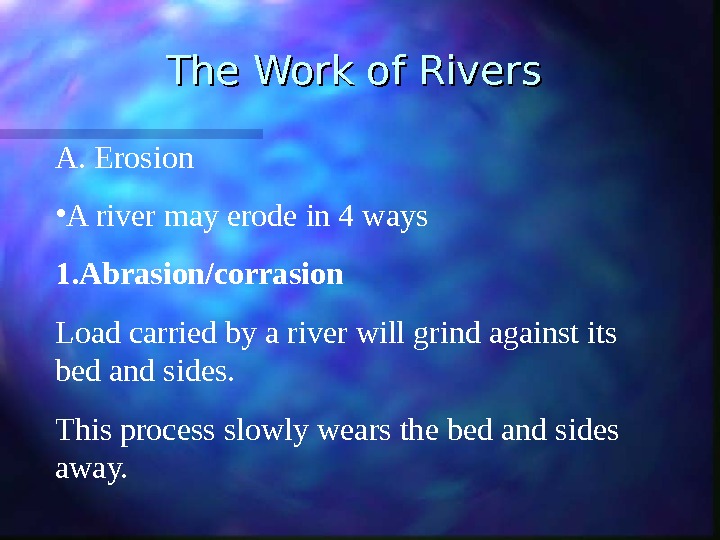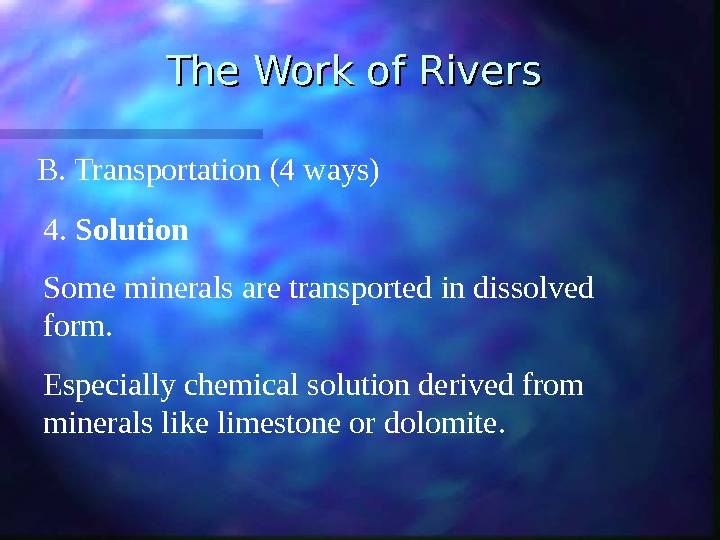The Work of Rivers The Work of





















- Размер: 19 Mегабайта
- Количество слайдов: 20
Описание презентации The Work of Rivers The Work of по слайдам
 The Work of Rivers
The Work of Rivers
 The Work of Rivers The erosional work of streams/rivers carves and shapes the landscape through which they flow. 3 functions of rivers a. Erosion b. Transportation c. Deposition
The Work of Rivers The erosional work of streams/rivers carves and shapes the landscape through which they flow. 3 functions of rivers a. Erosion b. Transportation c. Deposition
 The Work of Rivers A. Erosion • A river may erode in 4 ways 1. Abrasion/corrasion Load carried by a river will grind against its bed and sides. This process slowly wears the bed and sides away.
The Work of Rivers A. Erosion • A river may erode in 4 ways 1. Abrasion/corrasion Load carried by a river will grind against its bed and sides. This process slowly wears the bed and sides away.
 The Work of Rivers A. Erosion 2. Attrition When thrown against the sides and bed of rivers, the load gets broken into smaller pieces.
The Work of Rivers A. Erosion 2. Attrition When thrown against the sides and bed of rivers, the load gets broken into smaller pieces.
 The Work of Rivers A. Erosion 3. Hydraulic action The work of turbulence in the water. Running water causes friction in the joints of rocks in a stream channel Joints may be enlarged Loosened fragments of rocks get swept away.
The Work of Rivers A. Erosion 3. Hydraulic action The work of turbulence in the water. Running water causes friction in the joints of rocks in a stream channel Joints may be enlarged Loosened fragments of rocks get swept away.
 The Work of Rivers A. Erosion 4. Solution/Corrosion Certain minerals in rocks like limestone can be dissolved in water. Rocks are then eroded.
The Work of Rivers A. Erosion 4. Solution/Corrosion Certain minerals in rocks like limestone can be dissolved in water. Rocks are then eroded.
 The Work of Rivers Relationship of velocity and sediment size to erosion
The Work of Rivers Relationship of velocity and sediment size to erosion
 The Work of Rivers B. Transportation (4 ways)
The Work of Rivers B. Transportation (4 ways)
 The Work of Rivers B. Transportation (4 ways) 1. Traction Larger and heavier rocks/gravels are dragged or rolled along the bed.
The Work of Rivers B. Transportation (4 ways) 1. Traction Larger and heavier rocks/gravels are dragged or rolled along the bed.
 The Work of Rivers B. Transportation (4 ways) 2. Saltation ( saltim: by leaps/jumps) Smaller and lighter rock fragments and sand hop and bounce along the river bed. At times, the distinction between traction and saltation may be difficult to determine.
The Work of Rivers B. Transportation (4 ways) 2. Saltation ( saltim: by leaps/jumps) Smaller and lighter rock fragments and sand hop and bounce along the river bed. At times, the distinction between traction and saltation may be difficult to determine.
 The Work of Rivers B. Transportation (4 ways) 3. Suspension Some of the load like silt and clay (fine-grained) will float along. They may only be deposited when stream velocity reaches near 0. Turbulence in the water is crucial in holding a load of sediments.
The Work of Rivers B. Transportation (4 ways) 3. Suspension Some of the load like silt and clay (fine-grained) will float along. They may only be deposited when stream velocity reaches near 0. Turbulence in the water is crucial in holding a load of sediments.
 The Work of Rivers B. Transportation (4 ways) 4. Solution Some minerals are transported in dissolved form. Especially chemical solution derived from minerals like limestone or dolomite.
The Work of Rivers B. Transportation (4 ways) 4. Solution Some minerals are transported in dissolved form. Especially chemical solution derived from minerals like limestone or dolomite.
 The Work of Rivers C. Deposition A river will drop its load when: a. Volume decreases b. Speed decreases
The Work of Rivers C. Deposition A river will drop its load when: a. Volume decreases b. Speed decreases
 The Work of Rivers C. Deposition A river’s volume decreases when • Dry season • Dry region with high evaporation • Presence of permeable rocks • Receding flood waters
The Work of Rivers C. Deposition A river’s volume decreases when • Dry season • Dry region with high evaporation • Presence of permeable rocks • Receding flood waters
 The Work of Rivers C. Deposition A river’s speed decreases when • It enters a lake • It enters a calm sea • It enters a gently sloping plain
The Work of Rivers C. Deposition A river’s speed decreases when • It enters a lake • It enters a calm sea • It enters a gently sloping plain
 The Work of Rivers The work of a river depends on its energy Energy a function of a. Volume of water b. Speed of water flow (dependent on gradient)
The Work of Rivers The work of a river depends on its energy Energy a function of a. Volume of water b. Speed of water flow (dependent on gradient)





